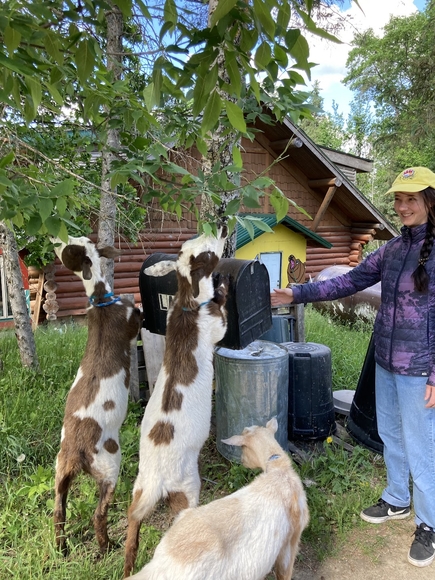Using Indigenous Agricultural Practice to build Sustainable Indigenous Economies and Environmental Policies
The Human Rights Program believes strongly in the importance of integrating professional experience with academic knowledge in the field of human rights, making internships a main requirement of the Master of Human Rights (MHR) degree program. Many students do amazing work with their host organizations and gain valuable field experience to supplement their human rights coursework. In this Q&A series, we interview our students to learn more about their experiences. In the fourth Q&A of the series, we are joined by Isabel Huot-Link, a second-year MHR student who interned with the Anishinaabe Agriculture Institute.
Human Rights Program (HRP): Can you tell us more about your educational background, specifically at the University of Minnesota, and your professional experience? How did both contribute to your decision in choosing these particular internships and the host organizations?
Isabel Huot-Link (IHL): I am a Master of Human Rights candidate with a concentration in the political ecology of education. In undergrad I studied theater and Spanish, afterward working in Saint Paul Public Schools as an Art educator and Spanish interpreter. I began a Fulbright English Teaching Assistantship in Arequipa, Perú in 2020, cut short due to the Covid-19 pandemic, and have since been considering ways to connect more deeply with my community here in the Twin Cities, where I have lived most of my life. The Line 3 pipeline resistance movement in 2021 sprung forward my engagement with local environmental activism. This deep, experiential learning showed me the importance of connecting to land, following Indigenous leadership, and protecting the water that brings us all life.
Spending the summer on the White Earth Reservation with the Anishinaabe Agriculture Institute (AAI) researching Indigenous agriculture was an easy choice due to the relationships and commitments I built during the Line 3 pipeline resistance movement. AAI is working on developing heritage Indigenous agricultural practices to build a sustainable economy for rural Indigenous communities. Focusing on youth education, fossil fuel-free farming, and community integration, this organization is creating the world that is necessary to survive the climate crisis. I chose to intern with this organization to deepen my relationship to this land and engage in community-led social action.
HRP: Please describe your summer internship, the host organization, your role in the organization, and the projects you worked on.
IHL: As a Graduate Research Intern with the Anishinaabe Agriculture Institute, I lived onsite on the White Earth Reservation developing organizational communications including a policy report, assisting with farm tasks, and making new connections (including several goats and many kittens).

My main project during the internship was to work on a policy report about industrial potato agriculture’s impact on Indigenous community members on and around the White Earth Reservation through groundwater draining and pollution, chemical spraying on schools and homes, and soil degradation. My knowledge of DNR groundwater policy, and local job economies exploded during the research and writing of this report, as I came in with limited background in any of these subjects. Alongside Anishinaabe environmentalist Winona LaDuke and the Honor the Earth leadership, I collaborated in researching, writing, and editing a final draft of this report, written for community members and local government bodies such as the DNR alike to understand and move to action around protecting northern Minnesotan ecosystems and people.
During this research, I interviewed community members about their experiences with and understandings of Industrial agriculture’s pollution of the land and water, and those impacts on local people. As these interviews went on, shared values began to build a throughline between their individual stories, and I joined in Winona LaDuke’s efforts to build a Shell River Alliance between Indigenous and non-Indigenous local community members who share the values of protecting the water from pollution. I bridged connections between community leaders and participated in Alliance meetings.
Beyond organizing, I was able to engage with farm life. I got to learn how to grow heritage potatoes organically, without the harsh chemical pesticides that industrial potato growers soaked their plants with. Very exciting stuff (involving picking a lot of bugs off of potato leaves). Joining AAI staff in shopping for seedlings at the Amish farms, planting at AAI’s four farm locations, sharing community meals, and learning when and where to harvest wild blueberries, I developed a deeper understanding of what environmental justice really means.
HRP: How did the internship add to your professional experience and personal growth? and how do you see it impact your career trajectory?
IHL: This internship built strong community connections, developed my understandings of environmental policy analysis and Indigenous community development, and reaffirmed my drive to continue working in education. I had been interested in working in a community college when I came into grad school, and that interest has narrowed to the possibility of tribal college teaching upon engaging with the community ties of the White Earth Tribal and Community College during my internship. This internship reaffirmed the knowledge that Indigenous leadership is essential for climate and environmental justice, and interdependent local communities are necessary for human survival. In a larger organization, I would not have been able to develop the connections and maintain the flexibility to engage in the ways I did in this small, local organization. Through this internship, I am reassured in my desires to collaborate with small local and grassroots organizations working on local-scale social change, and translate those connections into the classroom.
HRP: In your opinion, what is the importance of restoring a culturally-based economy in ensuring Indigenous rights and self-autonomy?
IHL: It's commonly known that Indigenous peoples are consistently the most impacted by climate change, while Indigenous ways of knowing develop strong human relationships with the land. Indigenous knowledge and ways of knowing may serve, if shared, as directions for how to mitigate climate change. Indigenous peoples must be able to practice self-determination through culturally-based local economies to fulfill their human rights and to build a future beyond this crisis. Settlers in the United States can be allies in this effort, when invited, to support Indigenous efforts to protect the land and water and learn from Indigenous ways of living with the land to reduce harmful lifestyle practices that degrade the environment. Some ways that settlers are invited to be allies is through mutual aid efforts, donating to Indigenous organizations, joining Water Protector efforts to prevent fossil fuel industry expansion, respecting Indigenous sovereignty and cultural autonomy, among many other ways. Humans will not survive the climate crisis without Indigenous leadership. Supporting Indigenous culturally-based economies is an essential step.
HRP: What are your recommendations for other students who are interested in pursuing a career that combines both environmental rights and human rights?
IHL: For others interested in internships relating to environmental issues or Indigenous peoples’ rights, I would highly recommend working with local, BIPOC-led organizations. Interning in Minnesota, where I grew up, was important in developing my connection to land, place, and my own community. Engaging with environmental policy through an Indigenous Anishinaabe organization was an important choice for me, to learn from and center those most impacted by climate change. Furthermore, look outside the typical range of environmental organizations, and beyond the buzzwords. An organization doing some of the most critical work like the Anishinaabe Agriculture Institute may take some digging to come across. Finally, don’t be deterred by any lack of a science background. I am a humanities person, and despite what some gatekeepers may say, there is space for all kinds of thinkers in the environmental justice movement.
There are many BIPOC-led organizations doing work to address environmental and human rights on local levels. Find out what local leaders in your community are asking people to do - reach out to see how you can engage.



